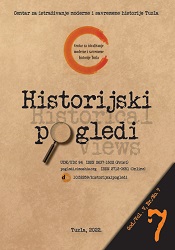Etnička struktura stanovništva Bosne i Hercegovine od 1948. do 1991. godine s posebnim akcentom na Bosansko Podrinje
Ethnic Structure of the Population of Bosnia and Herzegovina from 1948 to 1991 with Special Accent to the Bosnian Podrinje
Author(s): Sead SelimovićSubject(s): Social history, Demography and human biology, WW II and following years (1940 - 1949), Post-War period (1950 - 1989)
Published by: Centar za istraživanje moderne i savremene historije Tuzla
Keywords: Bosnia and Herzegovina; Bosnian Podrinje; ethnic structure of the population; period 1948-1991; Bosniaks; Serbs; Croats; Others; peace;
Summary/Abstract: In addition to human losses, the Second World War caused great damage to the economy of Bosnia and Herzegovina, especially to the industry that was exposed to severe destruction and damage. The situation was similar in the Bosnian Podrinje, and in the whole of northeastern Bosnia, where many residential buildings were destroyed. The Communist Party was not active in northeastern Bosnia, leaving room for its political and ideological opponents. More or less „ Chetnik and Ustasha groups " were moving around the surrounding forests, attacking the local population, harassing and looting them. The period of peace and stability .from 1945 to 1991 enabled, among other things, the strong economic, educational, cultural and demographic development of Bosnia and Herzegovina. After the end of the Second World War, Bosnia and Herzegovina had an area of 51,121 km2. According to the 1948 census, 2,565,277 people lived in the area. There were 1,237,381 males and 1,327,896 females. There were 498, 294 households. According to the 1 948 census, there were 1 , 1 3 6, 1 1 6 Serbs (44. 29%), 788,384 Bosniaks (30.73 %), 614,142 Croats (23.94%), 4,338 Slovenes (0.17%), and 675 Macedonians (0.03%), Montenegrins 3,094 (0. 12%), other Slavs 1 2, 94 7 (0. 50%), non-Slavs 5, 338 (0. 21 %) and unknown 193 (0.007%). In 1 948, the Bosnian Podrinje consisted of eight districts (counties) : Bijeljina, Foča, Goražde, Rogatica, Srebrenica, Višegrad, Vlasenica and Zvornik. At that time, Bratunac was in the Srebrenica County, and Čajniče was in the Goražde County. In this area lived 326, 930 inhabitants. There were 123,798 Bosniaks (37.87%), 199,232 Serbs (60.94%), 2,938 Croats (0.90%), 78 Slovenes (0.02%), 41 Macedonians (0.01%), and 194 Montenegrins. 0.06%), other Slavs 144 (0.04%), non-Slavs 194 (0.06%) and unknown 21 (0.006%). In 1948, Bosniaks made up the majority of the population in the counties of Goražde and Zvornik, and Serbs in the counties of Bijeljina, Foča, Rogatica, Srebrenica, Višegrad and Vlasenica. According to the 1 991 census, there were 4, 3 7 7, 033 inhabitants in Bosnia and Herzegovina. The most numerous people were Bosniaks, of whom there were 1, 902, 956 or 43. 50%. There were 1,366,104 Serbs or 31.21%, 760,852 Croats or 17.38%, 242,682 Yugoslavs or 5.54%, the other 104,439 or 2.38%. According to the 1991 census, there were 412,729 inhabitants in the Bosnian Podrinje area, which is 10,136 or 2.52% more than in 1981. In the ethnic structure of the population, the most numerous were Bosniaks, who numbered 223,955 (54.26%). There were 170,402 Serbs (41.29%), 1,312 Croats (0.32%), 8,451 Yugoslavs (2.05%) and 8,960 others (2.17%). In the period from 1948 to 1991, the population of Bosnia and Herzegovina increased from 2,565,277 to 4,377,033, which is an increase of 1 , 81 1, 756 persons (70. 62%). The number of Bosniaks increased from 788, 384 to 1, 902, 956 persons, which is an increase of 1, 1 14, 5 72 persons (1 41 . 3 7%). Serbs recorded an increase from 1, 1 3 6, 1 1 6 to 1, 366, 1 04 persons, an increase of 229, 988 persons (20.24%), and Croats from 614, 142 to 760, 852 persons, an increase of 1 4 6, 71 O persons (2 3. 89%). The number of others increased from 26, 585 to 34 7, 1 21 people, which is an increase of 320, 536 people (1205. 70%). In 1 948, Bosniaks made up 3 0. 73 % of the total population of Bosnia and Herzegovina, Serbs 44.29%, Croats 23. 94% and Others 1.04%. In 1991, Bosniaks accounted for 43. 50%, Serbs 31.21%, Croats 17.38% and Others 7. 93 % of the total population of Bosnia and Herzegovina. In the area of the Bosnian Podrinje, the number of inhabitants, in the period 1 948-1991. year, increased from 326,930 to 412,729, which is an increase of 85, 799 people (26.24%). Bosniaks had an increase from 123, 798 to 223, 965 persons, which is an increase of 1 00, 1 67 persons (80.90%). Serbs recorded a decrease from 1 99, 322 to 1 70, 402 persons, which is a decrease of 29, 396 persons (14. 5 1 %), and Croats from 2, 938 to 1 , 3 1 2 persons, which is a decrease of 1, 626 persons (55. 66%). The number of Others increased from 672 to 1 7, 4 1 1 persons, which is an increase of 1 6, 739 persons (2490.92%). In 1948, Bosniaks made up 3 7. 8 7% of the total population of the Bosnian Podrinje, Serbs 60.94%, Croats 0. 90% and Others 0. 21%. In 1 991, Bosniaks made up 54.26%, Serbs 41. 29%, Croats 0. 32% and Others 0. 40% of the total population of the Bosnian Podrinje. During the socialist period, the number of Bosniaks in the total population of the Bosnian Podrinje continuously increased due to stable natura! growth, peace, developed economy, health and the fact that a significant number of Bosniaks „ hid " in Yugoslavs and other groups. At the same time, the number of Serbs and Croats in the total population of this area was decreasing. This was, first of all, due to the departure of Serbs and Croats to neighboring Serbia, ie Croatia for employment or education.
Journal: HISTORIJSKI POGLEDI
- Issue Year: V/2022
- Issue No: 7
- Page Range: 217-253
- Page Count: 37
- Language: Bosnian

